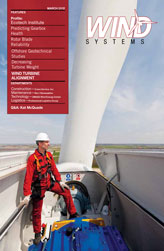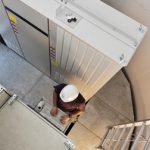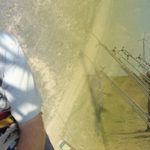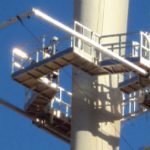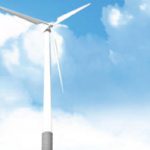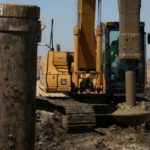Precision alignment is the process of making the two shafts co-linear under normal operating conditions. Properly aligned shafts are able to spin freely and not induce other unwanted forces to the system. These unwanted forces will damage and/or destroy bearings, seals, and couplings, and eventually the gearbox or generator. Precision alignment is recommended by most wind turbine manufacturers for optimal operation and reliability. Generator efficiency can also be affected by misalignment (angular and offset). The following questions—and answers—will help you to enhance the productivity and longevity of your turbine.
What needs to be aligned in a wind turbine?
The shafts of the gearbox and generator need to be aligned. The output bearing of the gearbox and the input bearing of the generator are most likely to suffer damage from misalignment.
When should I perform an alignment in a wind turbine?
An alignment should be performed upon commissioning. The nacelle has traveled a long way, probably by truck, so there is no guarantee that the factory alignment is still good. Anytime a gearbox or generator is replaced, an alignment should be performed. Because of the movement of the tower and other dynamic forces, a best practice is to re-check the alignment six months after the initial install and a minimum of every year after. Consult your turbine’s maintenance manual for recommendations.
What safety precautions are needed for wind turbine alignment?
Safety should be the very first consideration up tower. Check with the turbine manufacturer for specific safety requirements, but generally the brake should be engaged, dead bolts locked, blades pitched at 9:00, and the nacelle up against the wind. Alignment should not be tried in wind speeds ~over 8 m/s.
Does tower movement affect alignment measurements?
All movement can affect the laser measurements. Wind turbines present unique challenges because the gearbox and generator will not always move the same way at the same time. Use a laser measurement system that will allow you to increase the number of readings taken during the recording of each measurement. Five seconds per recording will provide more than enough data for accuracy.
I can only measure at the 6:00 position, not the 12:00 position—what now?
The 12:00 position can be replaced by the 6:00 position in the measurement process using a traditional 9:00-12:00-3:00 measurement method. When this is the case, the vertical movements will be accurate, but opposite (i.e. high will be low, and low will be high). Measuring units (laser/detector) that incorporate inclinometers will usually compensate for the different position automatically, providing accurate readings in the correct direction. Figure 1
What are the main differences between the three measurement method and limited (40° or 60°) measurement?
Many laser systems employ inclinometers for limited turn or sweep measurement. The inclinometers tell the system where the measuring units are in space so it can make the correct calculations based on the measurement position. Inclinometers will be affected by any movement in the nacelle. This movement can be seen on screen and will affect the measurement. Measurement filters (see question two) will help compensate for this movement. The three measurement method is accomplished by making three static measurements at 9:00, 12:00, and 3:00 when viewing the generator from the rear. This procedure will turn off the inclinometers reducing the effect. The measuring units will still “see” any generator/gearbox movement, but the inclinometers won’t add to the effect. The measurement filter can be used to minimize the effect.
Where should the measuring units be positioned during generator movement?
The most accurate readings when moving the generator will be achieved when the measuring units are in the same plane as the movement. When moving the gearbox horizontally, the measuring units should be in the 3:00 position. When moving vertically, the measuring units should be in the 12:00 position. If, for example, you are in the 2:00 position when moving horizontally, you will induce error into the readings and, thus, once you are within tolerance, you should re-measure and move again.
What if the brake is in the way at 9:00 and/or 6:00?
In many wind turbines access to 9:00 and 3:00 (and sometimes 12:00) may be prohibited by the brake calipers when using the traditional chain and bracket mounting fixtures. Magnetic fixtures can be used with mounting rods to position the measuring units inside the brake calipers on the brake disc. Care should be taken to ensure that the laser references the centerline of the shaft. The measuring units on either side need to be placed so as to reference their corresponding centerlines.
Should I align with the coupling in or out?
When performing an alignment with the coupling in, you will need to disengage the brake to rotate the shafts. All health and safety standards must be followed in this case. Without the coupling you can use the flange or shaft end to mount the units and turn without disengaging the brake. Figure 2
How do I decide on alignment tolerances?
Generally, alignment tolerances are determined by the RPM speed of the machine. The speed of the shaft is determined by the gearbox. Depending on the wind available, this speed can vary. The tolerances should be set for the highest allowable speed of the gearbox.
What is dynamic offset and why is it important?
Dynamic offset is caused by the movement of either machine under normal operating conditions. This movement can be caused when temperatures are different from one side of the system to the other. This is called thermal growth. Dynamic offset is caused in a wind turbine when the brake is released and the hub starts to turn. The weight of the system may cause the gearbox to shift upwards (in the vertical direction). When this happens, the shafts of the gearbox and generator are no longer in alignment.
How can I calculate dynamic offset in a wind turbine?
That should be a part of the turbine manufacturer’s specification. They know how much the turbine/gearbox will rise or move depending on dynamic forces in different situations. When using a laser alignment tool, make sure it includes a program for Thermal Growth (Dynamic) Compensation.
What is soft foot, and why is it important?
Soft foot is the condition where the machine stands on three feet instead of four. This of course means that the machine is standing unstable on the foundation. Soft foot must be corrected before alignment. A machine with a soft foot condition will continue to move during alignment, making a good job virtually impossible. Because of the generator and gearbox mounting base tolerances, soft foot may not be applicable in generator alignment. Should you find that alignment is extraordinarily difficult, check for soft foot as the culprit. Figure 3
What other tools will I need?
A good supply of clean shims, feeler gauges to help measure soft foot, micrometers can be used to measure the shim pack, a wire brush is used or cleaning foundations and shims. A good plan and a good tool kit will help prevent the need to go back down tower. When performing an alignment without the coupling, you will need a distance gauge to measure the distance between the flanges. Because many manufacturers are using a carbon fiber coupling that has a tight specification, the axial distance is critical when you align and move the generator.
What should I be concerned about with documentation?
Electronic documentation is the first quality check to ensure that techs have been trained properly and understand how to do alignments that are with in tolerance, ensuring good alignments every time. Good documentation will also help make subsequent jobs go more quickly and easily. O&M companies should be able to provide their customer with a document that shows what was done, who did it and that it was done properly and to tolerance. Documentation should be digital, recordable, and electronically storable. The document should include the final offset and angular misalignment for both the horizontal and vertical direction. Documentation should include the operator and the time and date the alignment performed. The documentation system should also have the ability to record and store any problems or obstacles noted by the technician for future reference. The document should be made available to the technician prior to performing a new alignment.



















